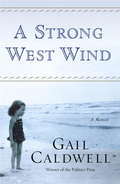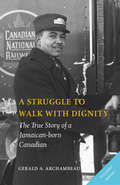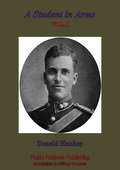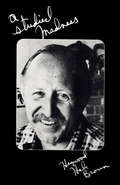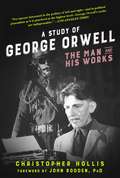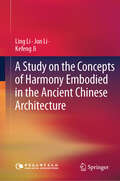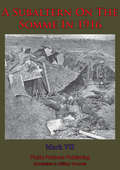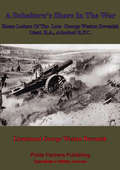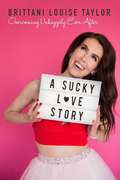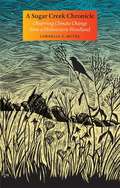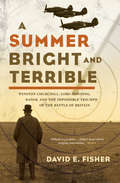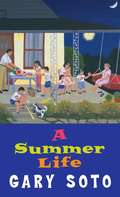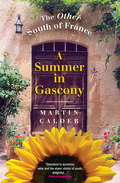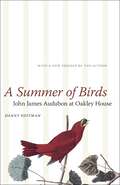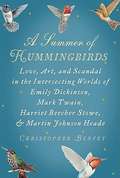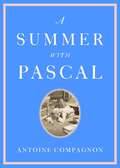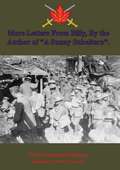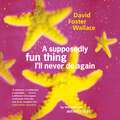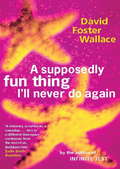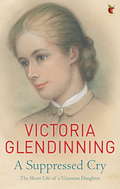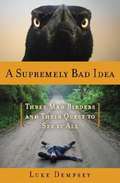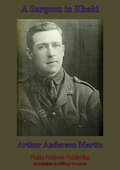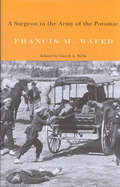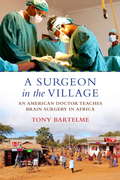- Table View
- List View
A Strong West Wind: A Memoir
by Gail CaldwellIn this exquisitely rendered memoir set on the high plains of Texas, Pulitzer Prize winner Gail Caldwell transforms into art what it is like to come of age in a particular time and place. A Strong West Wind begins in the 1950s in the wilds of the Texas Panhandle–a place of both boredom and beauty, its flat horizons broken only by oil derricks, grain elevators, and church steeples. Its story belongs to a girl who grew up surrounded by dust storms and cattle ranches and summer lightning, who took refuge from the vastness of the land and the ever-present wind by retreating into books. What she found there, from renegade women to men who lit out for the territory, turned out to offer a blueprint for her own future. Caldwell would grow up to become a writer, but first she would have to fall in love with a man who was every mother’s nightmare, live through the anguish and fire of the Vietnam years, and defy the father she adored, who had served as a master sergeant in the Second World War. A Strong West Wind is a memoir of culture and history–of fathers and daughters, of two world wars and the passionate rebellions of the sixties. But it is also about the mythology of place and the evolution of a sensibility: about how literature can shape and even anticipate a life. Caldwell possesses the extraordinary ability to illuminate the desires, stories, and lives of ordinary people. Written with humanity, urgency, and beautiful restraint, A Strong West Wind is a magical and unforgettable book, destined to become an American classic. From the Hardcover edition.
A Struggle to Walk With Dignity: The True Story of a Jamaican-born Canadian
by Gerald A. ArchambeauGerald Augustus Archambeau was born in Jamaica in 1933. Raised in Kingston by his three aunts, he was sent to Canada in 1947 to join his mother and stepfather in Montreal. He trained in the plumbing and steam-fitting trade, but at age eighteen decided to join the railway as a passenger car porter. He worked for Canadian Pacific and Canadian National until the 1960s, when declining passenger rail traffic and the ascendence of air travel caused him to switch to a career with a major Canadian airline in Toronto. After his retirement from the airline, Gerald and his wife, Marion, settled in St. Catharines, Ontario.
A Student In Arms Vol. I (A Student in Arms #1)
by John St Loe Strachey Donald StracheyAfter Donald Hankey returned home from a posting with the Royal Garrison Artillery in Mauritius, following a serious bout of illness, it seemed as though he was destined for a career in the Church. Finding the clergy schools to be too stultifying, he set to work in missionary positions in the most impoverished communities in the east of London. As the First World War began to take its ominous toll of men, the first of Kitchener's recruiting calls was heard throughout the Empire; Hankey eschewed returning to the army as an officer and decided to enlist as a "gentleman ranker". However, his previous military experience marked him out and he was promoted, soon after which he would embark on his first tour of duty on the Western Front. Wounded at Ypres in a daylight infantry charge across no man's land, and having been published previously, he began to send articles to the Spectator from the front. He finally met his end on 12th October 1916 during the later phases of the battle of the Somme.John St Loe Strachey, the then editor of The Spectator, put together the articles along with unpublished papers to produce the two volume "A Student In Arms" as a tribute and memorial to Donald Hankey. Initially published in America to ensure that it passed censorship, it became a bestseller on both sides of the Atlantic in short order running to many editions (this text is taken from the 16th edition). The two volumes are often reflective in tone, between the jingoistic volumes produced at the beginning of the war and the despairing disillusioned books produced afterward. It is also clear the affinity that Hankey felt for the common soldier, and made no secret of the fact that he believed that the ranker who had so little to gain from sacrificing himself for the society at home put many of his supposed betters to shame.
A Studied Madness
by Heywood Hale BrounBrought back into print after 14 years and published in paperback for the first time, this leisurely meditation on the art of acting and on the author's life in that art demonstrates a good-natured sense of humor and an engaging style. In a series of essays, Broun gently knocks the theatrical world--the audience traveling from small town to small town only to have a production fold right outside of New York; the trauma of doing live TV; getting bit parts in commercials or horror movies after years of classical training; and so on. Oddly enough, while deglamorizing his profession, he makes a good case for it: he enjoyed his life.
A Study of George Orwell: The Man and His Works
by Christopher Hollis PhD John RoddenAuthor Christopher Hollis knew George Orwell personally during his schooldays at Eton, afterwards in Burma, and at the end of his life. His study of Orwell’s books is therefore illuminated by some anecdotes of reminiscence. However, it is important to note that this book is primarily a study rather than a biography. Hollis examines Orwell’s books in order and traces through them the development of this unmatched literary giant’s thought process. From the experiences described in Down and Out in Paris and London to the points in his life that began driving him toward socialism, A Study of George Orwell is a comprehensive overview of Orwell’s work as it related to his personal life. Hollis guides the reader all the way through Orwell’s oeuvre, including his two most famous books—Animal Farm and 1984—which are, arguably, the greatest literary protests of political power and tyranny ever penned. Portraying Orwell as a fearless champion of the common man and a follower in the footsteps of Jonathan Swift, Hollis offers a compelling review and analysis of Orwell’s work as well as a perspective not found by the average, distant biographer
A Study on the Concepts of Harmony Embodied in the Ancient Chinese Architecture
by Jun Li Ling Li Kefeng JiThis book explores the core concept of Chinese ancient architecture from a multidisciplinary perspective. It aims to contribute to the development, inheritance, and protection of Chinese ancient architectural culture, while also benefiting the sustainable development of modern architecture. This book follows a main line of inquiry, exploring the rich and harmonious ideas present in Chinese ancient architecture. It combines the traditional Chinese culture and architectural ideas, and examines the original thought that forms the foundation of the traditional Chinese architectural culture of “harmony” from various aspects. Firstly, the book describes the Taoist theory of the harmony between man and nature, as expressed through different architectural elements. Secondly, it discuses the system of harmony among people influenced by Confucianism. Lastly, it explores the significance of Buddhism in Buddhist architecture. Finally, it also examines the difference in the emodiment of harmonious ideas between Chinese and Western architectures. This book studies and analyzes the type and characteristics of Chinese ancient architecture, the architectural objects, and the simple ecological environment views contained within the architectural concept. It not only analyzes the historical development context, but also provides physical examples of architectural types, and explores the influence of regional environmental factors. The target audience for this book includes scholars in universities and scientific research departments, particularly those studying architectural aesthetics, history and philosophy, it is also suitable for the ordinary readers who have interest in Chinese traditional architectural culture.
A Subaltern On The Somme In 1916
by Mark Vii Pseud."The author of this memoir arrived on the Western Front to join 10th Bn. West Yorks in July 1916, shortly after the opening day of the Battle of the Somme in which his battalion had suffered the highest casualties of any battalion on that day - 710 of whom 306 were killed. His war ended in January 1917 when he was concussed by a shell exploding on the parapet in front of him.Regarded as one of the classics the book gives a vivid description of life in the trenches - the routine, the boredom , the mud and the horror. His war ended in January 1917 when he was concussed by a shell exploding on the parapet in front of him. Well recommended."-N&M Print Version
A Subaltern’s Share In The War: Home Letters Of The Late George Weston Devenish Lieut. R.A., Attached R.F.C.
by Lieutenant George Weston DevenishLieutenant Devenish celebrated his twenty-first birthday, his last in peace-time, on the 25th of July 1914; he was by this point in his short life a soldier by profession and by choice. Having left Charterhouse with a taste for military ways after training in the O.T.C., he decided that his chosen profession should be spent in the Royal Artillery and entered into further training at Woolwich. By the time war begun in 1914 he was a fully-fledged officer. However, an indomitable spirit and a thirst for a more personal form of combat led him into the Royal Flying Corps. The R.F.C. would mourn his passing on the 6th of June 1917, after only a year of having him in their ranks. George Devenish's name is inscribed on the walls of the Arras Flying Services War Memorial, one of the many Allied fliers who lost their lives during the First World War fighting in the skies above the Western Front. A kindly, sensitive man, but filled with a great deal of passion and pride, his letters are almost always upbeat and despite the carnage around him during the war, he never changed his "sunny disposition".Author -- Lieutenant George Weston Devenish 1893-1917Text taken, whole and complete, from the edition published in London, Constable and Company Ltd., 1917.Original Page Count - xviii and 177 pages.
A Sucky Love Story: Overcoming Unhappily Ever After
by Brittani Louise TaylorWhere does a moderately popular internet star who never leaves her house look for potential suitors? Online. Tinder, Bumble, Match.com, OkCupid—I tried them all. My thirty-one-year-old self clicked and swiped her little heart out, leading to more dates than I could count, and more disappointment than I was prepared for. Maybe you can relate. Maybe you know all too well the perils of modern dating. But let’s say, eventually, you meet someone. You think to yourself, “Wow, they’re perfect! Take me off the market, put a ring on it, knock me up, the whole enchilada, because they are ‘the one.’” Let’s also say that they “feel the same way” about you. Your life starts to make sense! All the pain, heartbreak, and frustration from past failed relationships was worth it. Slow clap. That’s how I felt about Milos. He was from Europe, a doctor, wealthy, athletic. He had an accent and a dog. Milos was textbook marriage material. For him it was “love at first sight,” but for me, it was “anxiety on every date.” Something was telling me to run—but for two years, the only running I did was straight into his arms. If only I would have listened. This isn’t a love story. It’s my story of survival.
A Sugar Creek Chronicle: Observing Climate Change from a Midwestern Woodland
by Cornelia F. MutelIn 2010, while editing a report on the effects of climate change in Iowa, ecologist Cornelia Mutel came to grips with the magnitude and urgency of the problem. She already knew the basics: greenhouse gas emissions and global average temperatures are rising on a trajectory that could, within decades, propel us beyond far-reaching, irreversible atmospheric changes; the results could devastate the environment that enables humans to thrive. The more details she learned, the more she felt compelled to address this emerging crisis. The result is this book, an artful weaving together of the science behind rising temperatures, tumultuous weather events, and a lifetime devoted to the natural world. Climate change isn't just about melting Arctic ice and starving polar bears. It's weakening the web of life in our own backyards. Moving between two timelines, Mutel pairs chapters about a single year in her Iowa woodland with chapters about her life as a fledgling and then professional student of nature. Stories of her childhood ramblings in Wisconsin and the solace she found in the Colorado mountains during early adulthood are merged with accounts of global environmental dilemmas that have redefined nature during her lifespan. Interwoven chapters bring us into her woodland home to watch nature's cycles of life during a single year, 2012, when weather records were broken time and time again. Throughout, in a straightforward manner for a concerned general audience, Mutel integrates information about the science of climate change and its dramatic alteration of the planet in ways that clarify its broad reach, profound impact, and seemingly relentless pace. It is not too late, she informs us: we can still prevent the most catastrophic changes. We can preserve a world full of biodiversity, one that supports human lives as well as those of our myriad companions on this planet. In the end, Mutel offers advice about steps we can all take to curb our own carbon emissions and strategies we can suggest to our policy-makers.
A Summer Bright and Terrible: Winston Churchill, Lord Dowding, Radar, and the Impossible Triumph of the Battle of Britain (Biography And Memoir Ser.)
by David E. FisherLord Hugh Dowding, Air Chief Marshall of the Royal Air Force, Head of Fighter Command, First Baron of Bentley Priory, lived in the grip of unseen spirits. In thrall of the supernatural, he talked to the ghosts of his dead pilots, proclaimed that Hitler was defeated only by the personal intervention of God, and believed in the existence of faeries. How could it be that such a man should be put in charge of evaluating technical developments for the British air ministry? Yet it was he who brought the modern multi–gunned fighter into existence. And he insisted that his scientists investigate the mysterious invisible rays that would prove to be the salvation of Britain: radar.Dowding, who provided the organization and training that led to victory, has been all but ignored by U. S. biographers of Churchill and historians of the Battle of Britain. Yet his story is vital to tell, for its importance to the defense of Britain and the free world, and for the intriguing character study that emerges from his ongoing conflict with Churchill and the British government during the crisis years of the empire. Part military history, part science narrative, part biography; this an incredible story.
A Summer Life
by Gary SotoGary Soto writes that when he was five "what I knew best was at ground level." In this lively collection of short essays, Soto takes his reader to a ground-level perspective, recreating in vivid detail the sights, sounds, smells, and textures he knew growing up in his Fresno, California, neighborhood. The "things" of his boyhood tie it all together: his Buddha "splotched with gold," the taps of his shoes and the "engines of sparks that lived beneath my soles," his worn tennies smelling of "summer grass, asphalt, the moist sock breathing the defeat of basesall." The child's world is made up of small things--small, very important things.
A Summer in Gascony, New Edition
by Martin CalderGascony's incredible culture and beautiful landscape shine as Martin Calder is introduced to "the other South of France." In the tiny hamlet of Peguilhan, Martin discovers the unique personalities of Jacques-Henri (the hardworking farmer), Anja (the lovely German student), Pattes (a trouble-making stray dog), and more-including the town gossip and a man with incredible Gascon heritage.
A Summer of Birds: John James Audubon at Oakley House (The\hill Collection: Holdings Of The Lsu Libraries Ser.)
by Danny HeitmanOver the summer of 1821, a cash-strapped John James Audubon worked as a tutor at Oakley Plantation in Louisiana’s rural West Feliciana Parish. This move initiated a profound change in direction for the struggling artist. Oakley’s woods teemed with life, galvanizing Audubon to undertake one of the most extraordinary endeavors in the annals of art: a comprehensive pictorial record of America’s birds. That summer, Audubon began what would eventually become his four-volume opus, Birds of America.In A Summer of Birds, Danny Heitman recounts the season that shaped Audubon’s destiny, sorting facts from romance to give an intimate view of the world’s most famous bird artist. A new preface marks the two-hundredth anniversary of that eventful interlude, reflecting on Audubon’s enduring legacy among artists, aesthetes, and nature lovers in Louisiana and around the world.
A Summer of Hummingbirds
by Christopher BenfeyThe country's most noted writers, poets, and artists converge at a singular moment in American life At the close of the Civil War, the lives of Emily Dickinson, Mark Twain, Harriet Beecher Stowe, and Martin Johnson Heade intersected in an intricate map of friendship, family, and romance that marked a milestone in the development of American art and literature. Using the image of a flitting hummingbird as a metaphor for the gossamer strands that connect these larger-than-life personalities, Christopher Benfey re-creates the summer of 1882, the summer when Mabel Louise Todd-the protégé to the painter Heade-confesses her love for Emily Dickinson's brother, Austin, and the players suddenly find themselves caught in the crossfire between the Calvinist world of decorum, restraint, and judgment and a new, unconventional world in which nature prevails and freedom is all. .
A Summer with Pascal
by Antoine CompagnonFrom an eminent scholar, a spirited introduction to one of the great polymaths in the history of Europe.Blaise Pascal (1623–1662) is best known in the English-speaking world for his contributions to mathematics and physics, with both a triangle and a law in fluid mechanics named after him. Meanwhile, the classic film My Night at Maud’s popularized Pascal’s wager, an invitation to faith that has inspired generations of theologians. Despite the immensity of his reputation, few read him outside French schools. In A Summer with Pascal, celebrated literary critic Antoine Compagnon opens our minds to a figure somehow both towering and ignored.Compagnon provides a bird’s-eye view of Pascal’s life and significance, making this volume an ideal introduction. Still, scholars and neophytes alike will profit greatly from his masterful readings of the Pensées—a cornerstone of Western philosophy—and the Provincial Letters, in which Pascal advanced wry theological critiques of his contemporaries. The concise, taut chapters build upon one another, easing into writings often thought to be forbidding and dour. With Compagnon as our guide, these works are not just accessible but enchanting.A Summer with Pascal brings the early modern thinker to life in the present. In an age of profound existential doubt and assaults on truth and reason, in which religion and science are so often crudely opposed, Pascal’s sophisticated commitment to both challenges us to meet the world with true intellectual vigor.
A Sunny Subaltern, Billy’s Letters from Flanders
by Anon Billy"An engaging collection of letters from a young Canadian officer, native to Toronto. His letters begin in late 1915 on the journey across the Atlantic to the European battlefield. He is filled with worldly-wonder and naiveté as he encounters figures as diverse as Colonels to French peasants, and recounts the daily trials and tribulations of the soldiers life in Belgium with wit; for example, he describes his batman as "a soldier paid by you to be absent when you want him." Particularly interesting is the tone of the narrative in which he attempts to educate his mother of life in the army, and in tone, cheerful beyond modern cyncism. Collected and posthumously published by his mother, they make for a gripping and atmospheric read.Author -- Anon "Billy"Text taken, whole and complete, from the edition published in Toronto, McClelland, Goodchild and Stewart, 1916.Original Page Count - 175 pages.
A Supposedly Fun Thing I'll Never Do Again
by David Foster WallaceA collection of insightful and uproariously funny non-fiction by the bestselling author of INFINITE JEST - one of the most acclaimed and adventurous writers of our time. A SUPPOSEDLY FUN THING... brings together Wallace's musings on a wide range of topics, from his early days as a nationally ranked tennis player to his trip on a commercial cruiseliner. In each of these essays, Wallace's observations are as keen as they are funny. Filled with hilarious details and invigorating analyses, these essays brilliantly expose the fault line in American culture - and once again reveal David Foster Wallace's extraordinary talent and gargantuan intellect.
A Supposedly Fun Thing I'll Never Do Again: Essays And Arguments
by David Foster WallaceA collection of insightful and uproariously funny non-fiction by the bestselling author of INFINITE JEST - one of the most acclaimed and adventurous writers of our time. A SUPPOSEDLY FUN THING... brings together Wallace's musings on a wide range of topics, from his early days as a nationally ranked tennis player to his trip on a commercial cruiseliner. In each of these essays, Wallace's observations are as keen as they are funny. Filled with hilarious details and invigorating analyses, these essays brilliantly expose the fault line in American culture - and once again reveal David Foster Wallace's extraordinary talent and gargantuan intellect.
A Suppressed Cry: The Short Life of a Victorian Daughter
by Victoria Glendinning'I always wanted everything so frantically, and I'm just the person that can't have them.' Based on family papers and memories, this picture of middle class life at the end of the nineteenth century tells the poignant story of Winnie Seebohm, Victoria Glendinning's great-aunt, who in 1885 was one of the early students at Newnham College, Cambridge. Though much loved by her family, Winnie was stifled in her desire for life and died at the age of twenty-two.
A Suppressed Cry: The Short Life of a Victorian Daughter
by Victoria Glendinning'I always wanted everything so frantically, and I'm just the person that can't have them.' Based on family papers and memories, this picture of middle class life at the end of the nineteenth century tells the poignant story of Winnie Seebohm, Victoria Glendinning's great-aunt, who in 1885 was one of the early students at Newnham College, Cambridge. Though much loved by her family, Winnie was stifled in her desire for life and died at the age of twenty-two.
A Supremely Bad Idea: Three Mad Birders and Their Quest to See It All
by Luke DempseyIt was an epiphany: The moment two friends showed Luke Dempsey a small bird flitting around the bushes of his country garden, he fell madly in love. But did he really want to be a birder? Didn't that mean he'd be forced to eat granola? And wear a man-pouch? Before he knew it, though, he was lost to birding mania. Early mornings in Central Park gave way to weekend mornings wandering around Pennsylvania, which morphed into week-long trips to Texas, Arizona, Michigan, Florida--anywhere the birds were. A Supremely Bad Idea is one man's account of an epic journey around America, all in search of the rarest and most beautiful birds the country has to offer. But the birds are only part of it. There are also his crazy companions, Don and Donna Graffiti, who obsess over Dempsey's culinary limitations and watch in horror as an innocent comment in a store in Arizona almost turns into an international incident; as a trip through wild Florida turns into a series of (sometimes poetic) fisticuffs; and as he teeters at the summit of the Rocky Mountains, a displaced Brit falling in love all over again, this time with his adopted country. Both a paean to avian beauty and a memoir of the back roads of America, A Supremely Bad Idea is a supremely fun comic romp: an environmentally sound This Is Spinal Tap with binoculars.
A Surgeon In Khaki [Illustrated Edition]
by Arthur Anderson Martin FRCSEA Kiwi surgeon recounts his experiences of life under fire tending to the wounded in the first year of World War One. Illustrated with more than 15 photos of the author, his unit and the locations of the battles he witnessed."Arthur Anderson Martin was born in Milton, Otago, New Zealand, on 26 March 1876...When war broke out that year [1914] he joined the Royal Army Medical Corps, serving in France and Belgium. His advocacy and practice of immediate specialist surgery - even under fire - for wounds to abdomen, chest, and upper femur, won acclaim in the British Medical Journal. He frequently placed himself at risk while tending the injured and was mentioned in dispatches by General John French in 1915 and General Douglas Haig in 1916. His book, A surgeon in khaki, was considered by critics to be a well-judged account of front-line medical conditions.After eight months' duty in the field he returned to New Zealand for rehabilitative rest. However, he was immediately appointed to a commission investigating accommodation and hospitalisation at Trentham camp after severe outbreaks of measles, pneumonia and cerebrospinal meningitis. It was thought by leading politicians that his reputation would give medical weight to the findings of the commission. Even during his brief return to civilian practice in Palmerston North he was active in training the Rifle Brigade Field Ambulance at Awapuni. He returned with them to France, and was soon back in front-line service on the Somme.He was wounded at Flers on 17 Sep. 1916, and died in Amiens base hospital the same night. The loss of two of New Zealand's most promising surgeons, Gilbert Bogle and Martin, on the same day led to the issue of orders for much more caution by doctors under fire than Martin had advocated. The death of a gifted surgeon was mourned in newspapers throughout New Zealand. On 1 Jan. he was posthumously appointed a DSO."-Te Ara Encyclopaedia Of New Zealand
A Surgeon in the Army of the Potomac
by Francis M. Wafer Cheryl A. WellsCheryl Wells provides an edited and fully annotated collection of Wafer's diary entries during the war, his letters home, and the memoirs he wrote after returning to Canada. Wafer's writings are a fascinating and deeply personal account of the actions, duties, feelings, and perceptions of a noncombatant who experienced the thick of battle and its grave consequences.
A Surgeon in the Village: An American Doctor Teaches Brain Surgery in Africa
by Tony BartelmeAn inspiring story of doctors who changed the health care of an African nationDr. Dilan Ellegala arrives in Tanzania, shocked to find the entire country has just three brain surgeons for its population of forty-two million. Haydom Lutheran Hospital lacks even the most basic surgical tools, not even a saw to open a patient’s skull. Here, people with head injuries or brain tumors heal on their own or die. When confronted with a villager suffering from a severe head trauma, Dilan buys a tree saw from a farmer, sterilizes it, and then uses it to save the man’s life.Yet Dilan realizes that there are far too many neurosurgery patients for one person to save, and of course he will soon be leaving Tanzania. He needs to teach someone his skills. He identifies a potential student in Emmanuel Mayegga, a stubborn assistant medical officer who grew up in a mud hut. Though Mayegga has no medical degree, Dilan sees that Mayegga has the dexterity, intelligence, and determination to do brain surgery. Over six months, he teaches Mayegga how to remove tumors and treat hydrocephalus. And then, perhaps more important, Dilan teaches Mayegga how to pass on his newfound skills. Mayegga teaches a second Tanzanian, who teaches a third. It’s a case of teach-a-man-to-fish meets brain surgery.As he guides these Tanzanians to do things they never thought possible, Dilan challenges the Western medical establishment to do more than send vacationing doctors on short-term medical missions. He discovers solutions that could transform health care for two billion people across the world.A Surgeon in the Village is the incredible and riveting account of one man’s push to “train-forward”—to change our approach to aid and medical training before more lives are needlessly lost. His story is a testament to the transformational power of teaching and the ever-present potential for change. As many as seventeen million people die every year because of a shortage of surgeons, more than die from AIDS, malaria, and tuberculosis combined. Dilan Ellegala and other visionaries are boldly proposing ways of saving lives.
